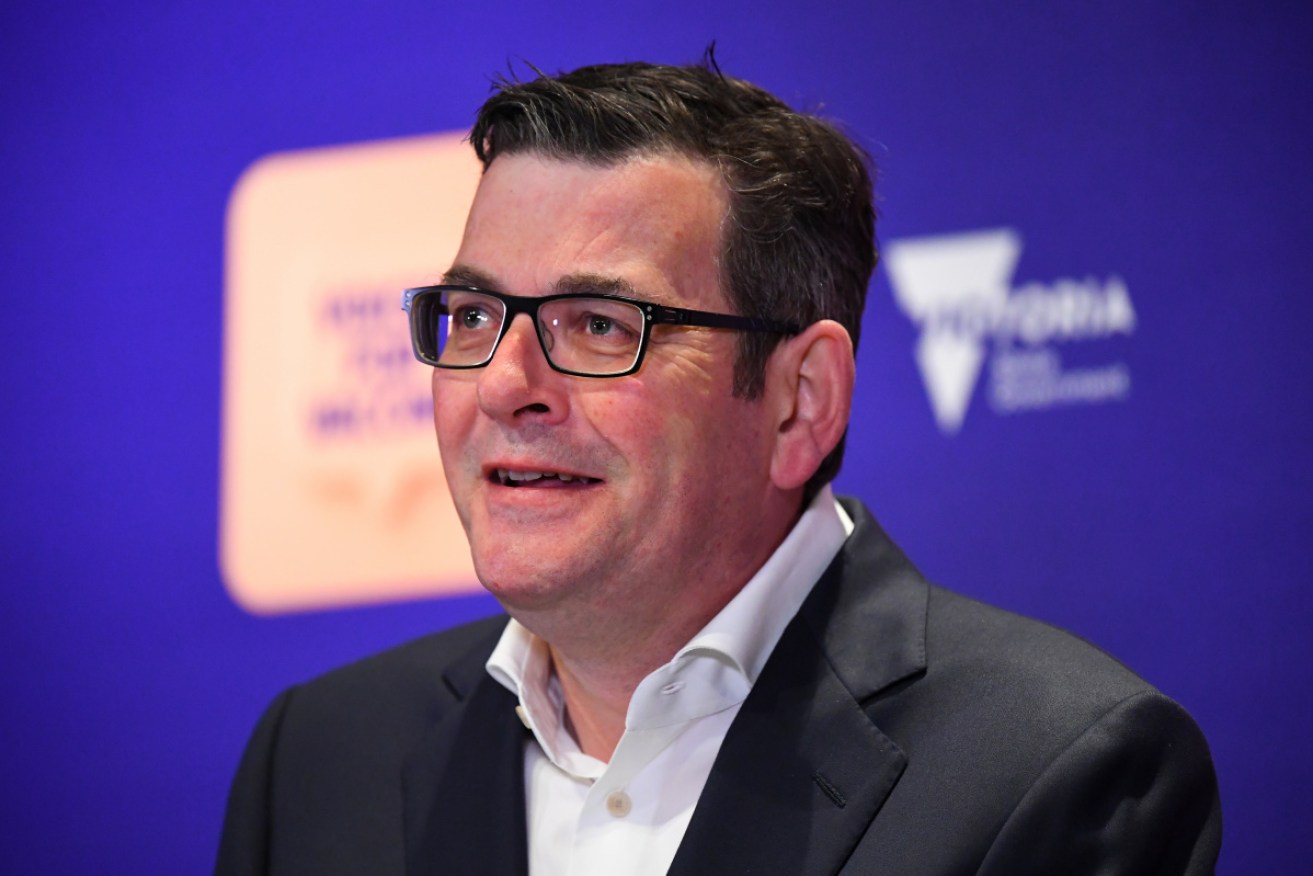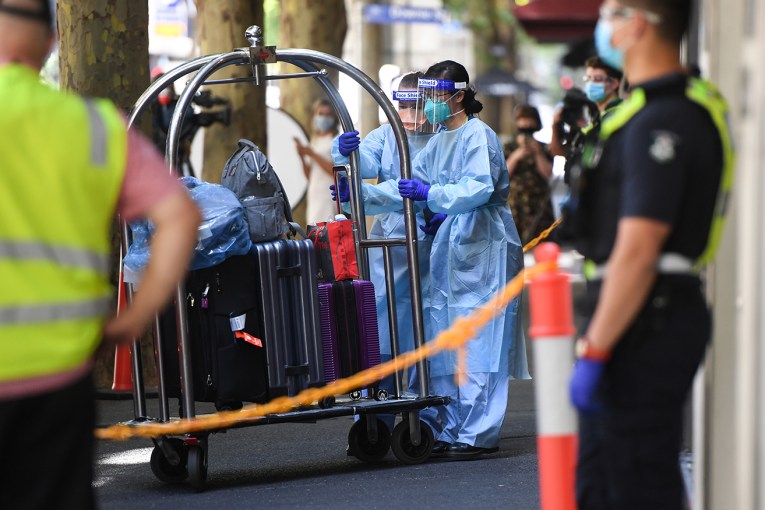COVID update: Proposed powers stir concern over future of lockdowns


A bill to go before parliament would give new powers to Victorian Premier Daniel Andrews. Photo: AAP
Premier Daniel Andrews would be given powers to declare a pandemic and the state’s health minister could decide on further lockdown rules, under new laws being considered in Victoria.
The Public Health and Wellbeing (Pandemic Management) Bill 2021 is expected to be introduced to the lower house when parliament resumes on Tuesday.
The bill would permanently replace the current state of emergency, which has been in place for more than 18 months and expires on December 15.
“The bill establishes several mechanisms designed to improve the transparency of pandemic decision-making and accountability of decision-makers to parliament and the community,” a summary of the bill reads.
According to the summary, sent to MPs on Monday night, the bill will provide the health minister with “broad powers to make pandemic orders” on the advice of the chief health officer.
Currently, only Chief Health Officer Brett Sutton can issue such orders.
The laws will bring Victoria in line with jurisdictions such as NSW and New Zealand, where the health minister is directly accountable to parliament.
Public health orders will be able to “differentiate between people in a range of settings according to public health risk: for example, vaccination status”, while the premier will have the power to “declare” a pandemic and extend it in three-month blocks for as long as considered necessary.
An aggravated offence will be created to “deter … the most egregious pandemic-related behaviours”, while court-imposed penalties will be introduced to stop businesses from receiving “any commercial benefit resulting from a breach of a pandemic order”.
An independent oversight committee will review public orders and their impact on human rights, while public health advice will need to be made public.
The government said it has consulted with community groups, health and human rights experts and legal stakeholders on the proposed laws.
The bill is expected to pass the lower house, where Labor has a commanding majority, but in the upper house the government will require the backing of three of the 11 crossbenchers.
Greens leader Samantha Ratnam said she had been negotiating with the government on the proposed laws, which she described as “a big improvement and much fairer for the whole Victorian community”.
The opposition has already fought back and, according to the ABC, will introduce a private member’s bill to limit the government’s ability to declare an emergency or pandemic for no more than 30 days unless it has a special majority vote in both Houses of Parliament.
This is scary stuff.
Nobody should have these powers to target people based on their ‘characteristics, attributes or circumstances’ #Springst https://t.co/4txwsfP80W
— David Southwick MP (@SouthwickMP) October 25, 2021
Expect the debate about the powers to dominate coronavirus news on Tuesday.
Here’s a wrap of what else is going on in states transitioning out of lockdown.
Victoria
Tuesday’s sitting is also the first since a vaccine mandate came into effect banning MPs from parliament if they refuse to provide proof of their vaccination status.
All members and staff are required to prove they’ve had one dose to continue working on-site, or have an appointment booked before October 22. They will also need to have their second dose by November 26.
It comes as Victoria recorded 1461 new locally acquired COVID-19 cases and seven deaths on Monday, including a woman in her 20s who had the virus but died of an unrelated cause. The deaths take the toll from the current outbreak to 230.
New exposure sites named late on Monday night included pubs, gyms, a pharmacy and cafes, in the following towns:
- Mildura;
- Yackandandah;
- Shepparton;
- Wodonga;
- Wangarratta.
More than 74 per cent of Victorians aged over 16 are fully vaccinated and the state is tipped to hit its 80 per cent target some time this weekend, with restrictions to ease further at 6pm on Friday.
Almost all coronavirus restrictions will end once 90 per cent of the population aged over 12 are fully vaccinated, forecast to occur about November 24. But restrictions will remain for the unvaccinated.
NSW
The majority of COVID-19 cases reported in NSW are now being diagnosed in the regions and smaller cities, rather than in Sydney where the Delta outbreak first took hold.
Of the 294 cases reported on Monday, 166 – or 56 per cent – were outside the state capital.
The caseload is highest in the Hunter New England local health district, which had the most cases of any district in the 24 hours to 8pm on Sunday – 59. It recorded 53 cases the day before, down from 78 the previous day.
Case numbers in southwest and western Sydney once dwarfed any other area, but Hunter New England has in the last week been the district with the highest caseload on three occasions.
The district takes in Newcastle, Tamworth, Glen Innes and Moree as part of its 131,785 square kilometre area.
There is also a notable surge in the Murrumbidgee Local Health District, which takes in the Snowy Mountains and the Riverina region in the state’s southwest.
That area reported 46 new cases on Monday, 47 on Sunday and 37 on Saturday.
The district has a population of about 243,00, compared to the 820,000 people serviced by the South Western Sydney Local Health District and the 920,000 in Hunter New England.
Concerns that vaccination rates were lower in the regions drove the NSW government’s decision to postpone unrestricted travel from Sydney until November 1.
Regional communities wanted more time to get their double dose vaccination rates as high as possible before welcoming back visitors.
Authorities reported four new deaths from the virus on Monday, including a person from the Central Coast.
Each person had underlying health conditions, said NSW Health. They were an unvaccinated person in their 40s, two people in their 60s with one dose of the vaccine, and a person in their 70s with both doses.
State-wide vaccination coverage is now at 85 per cent double-dose and 93.1 single-dose for over-16s.
Of children aged 12 to 15, 78 per cent have had their first dose and 51.5 per cent are fully vaccinated.
ACT
ACT health authorities are set to provide a major update on Canberra’s COVID-19 outbreak as the city’s vaccination rate continues to climb.
A detailed epidemiological update on the ACT’s coronavirus situation will be delivered on Tuesday along with the daily case numbers.
Meanwhile, Canberra’s vaccination rate is inching towards 90 per cent of people over 12 years of age being fully vaccinated.
The latest figures have shown 88 per cent of the eligible population having had two doses of the COVID-19 vaccine.
There were nine new cases reported in the capital on Monday, the second day in a row of infection numbers in the single digits.
However, it came amid a drop in testing rates with just 647 negative tests recorded.
As of Monday, there were 20 COVID-19 patients in Canberra hospitals, with half of them in intensive care, and 332 active cases in the community.
There have been 1595 COVID-19 cases in the ACT since its most recent outbreak began in August.
-with AAP








